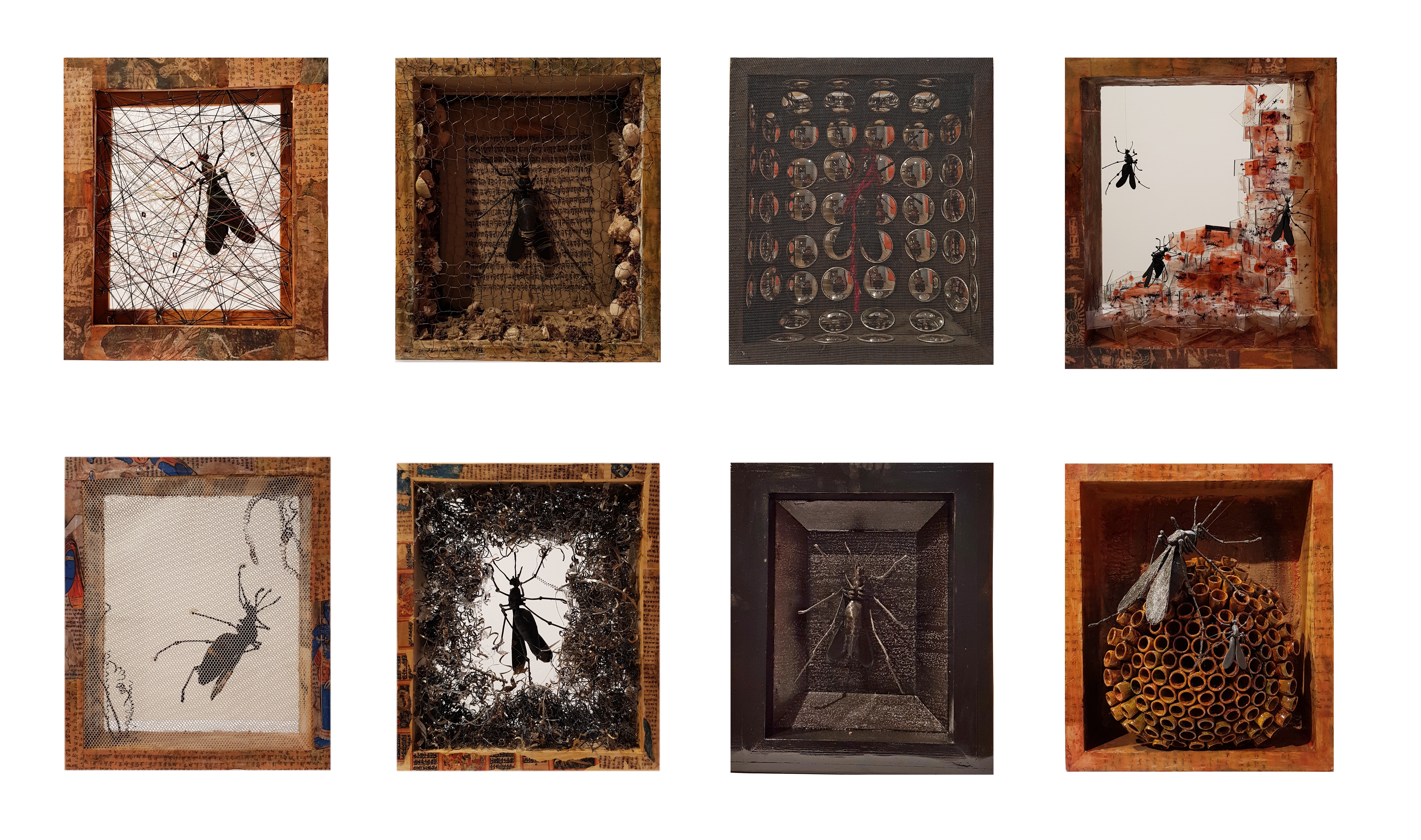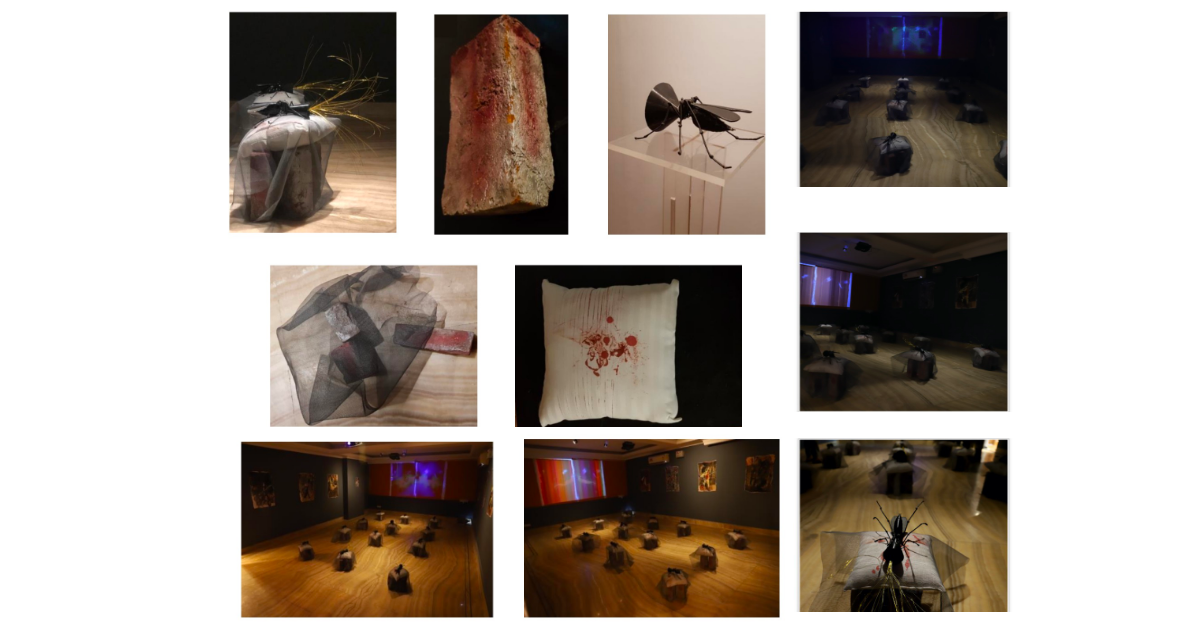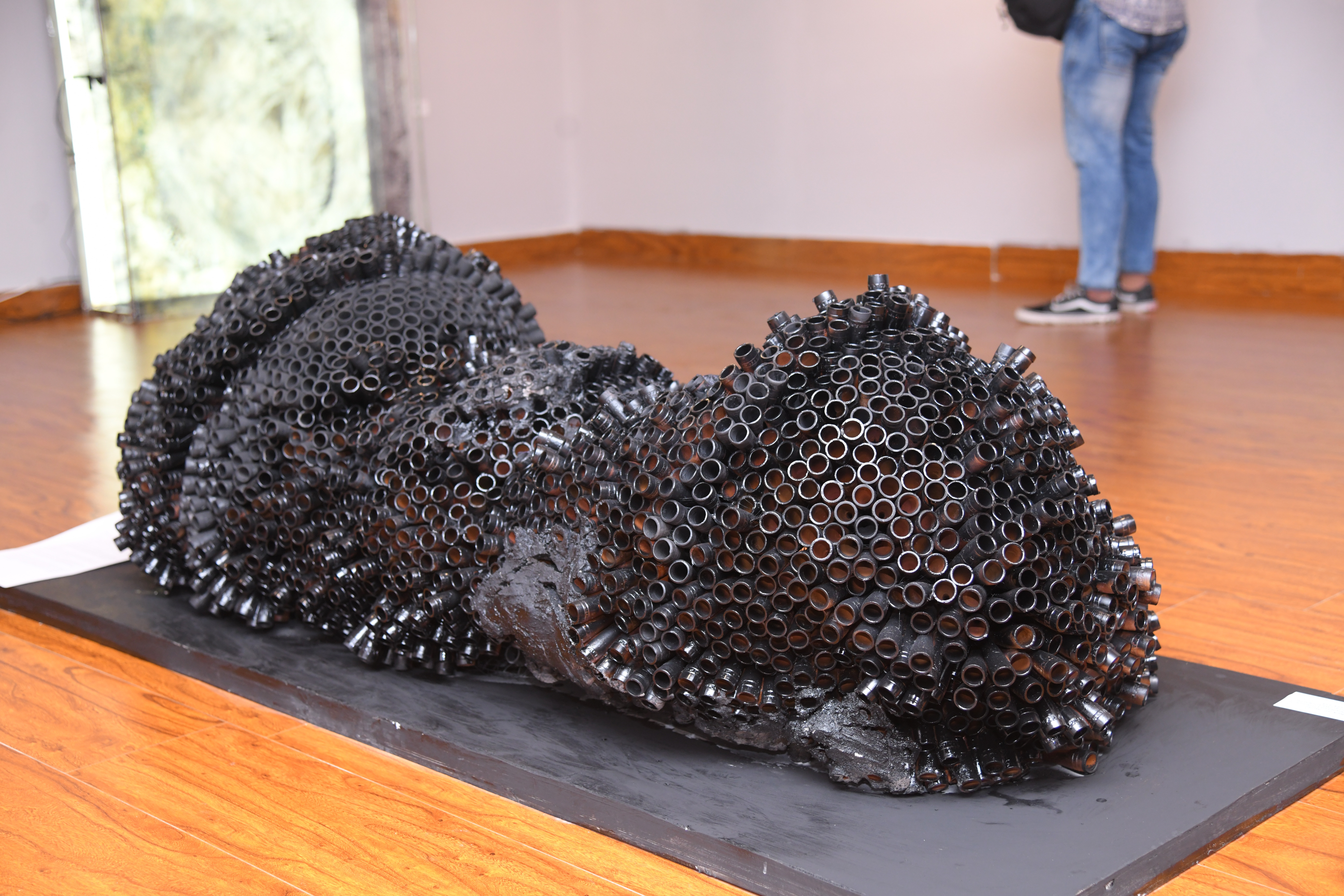© 2022 by NEHA TALWAR




Deductive Dilemma in Psychological Dimensions (Painted Lightbox)
Human thought is multidimensional, Apart from yes and no we calculate the maybes and maybe nots, we have the power to ponder over ifs and buts, and we can decide between the better and the best amongst the worst. As artists we wanted to investigate the deductive process of dialectics, potentially unraveling the hidden dimensions of rationality with regard to the indefinite developments in the science of artificial intelligence where the sole aim is to duplicate what exists as mortal in humanity. The pattern inhabits an impossible future that incorporates the probabilities of thought dimensions depicted as impulses of reasoning through machines and algorithms. In this installation, we have used multiple glasses symbolizing the possible 3D layers of rationale. The artwork on it expresses the impact of technological advancement on human anatomy and its impression on our perception as a union. The installation highlights the looming impact of technology on us and our civilization. Our artistic pursuit is to identify Artificial Intelligence as creating a ghost around us, everything that we do on a screen is documented as a digital us, It’s a copy. The light shown on the installation is inspired by Plato’s Tripartite theory of Soul in ‘The Republic’ around 380BC in which he propagates that both the human psyche and the society consist of these three parts. The first layer comprises the logic which seeks validity and is swayed by facts and arguments. Its conception as a map of our brain is a deliberate attempt to express the intricate details and complex network required to process the information. The second layer is anatomic yet spirited, it stresses the sensitivity of the emotional impulse and how our actions are fueled by our feelings. The third layer is .appetite, the physical desires that drive us into worldly pleasures and presents a case for vanity. The light source represents the intelligence that is imaginatively artificial.
121.92X121.92 cm 48X48 inchMACHHARNAMA CHAPTER ONE
The installation Machharnama draws inspiration from the Vedic and Samkhya Yoga practice of Ashtanga Yoga. The mosquito takes on a different aspect of the eight-fold path in each of the eight boxes of the Machharnama installation. The aim of this artistic installation is to highlight the fallacies of a human soul trapped amongst the daily routines of life and human emotions in the present socio-political scenario. The use of day-to-day materials is purely symbolic.
We used the mosquito as the central theme of the installation to symbolize the human soul and mind. The tiny presence is ubiquitous and omnipresent and ever pervading and depicts an unfathomable journey just like that of a human soul and mind. The goal is to effortlessly, and with some pleasantness to the experience, attain an exalted state of being despite the chaos of daily life.
MACHHARNAMA CHAPTER TWO
One drop Paradox
Mosquito buzzes in my ear
Shall I kill it or not?
Is it liberation for the Mosquito Will it give me Moksha... ever
The quest continues with the paradox of sharing one drop of our blood with the mosquito. Is it a big deal? Is it right to kill a mosquito? Today a billion-dollar business revolves around killing mosquitoes for better sleep. Is this good karma?
As an installation artist, I wanted to highlight multi-dimensional thought processes and artworks for this project.
The room was partially lit representing the silence of the night with sound art of varied effects of the imminent presence of mosquitoes. The walls were dark and illustrated digital art strategically colored with red and black ink but purposely torn to express the physical and emotional after-effects of a mosquito.
Pillared on bricks were many blood-stained pillows entangled along with the mosquito net and a unique sculpture of a mosquito with a mouth in the shape of a vehicle horn and many tentacles coming out of it.
The one drop paradox is simply whether we should kill mosquitoes or not for sucking a drop of our blood... I ponder.
The installation on the floor was pillared on abstract painted bricks, accentuating the rawness and representing the stings of the mosquitoes through the rough edges throughout. The blood art on top of the white pillow denoted the sufferings of human sleep and reminded us of the presence of the necessary evil. The use of a mosquito net was just to express its uselessness of it as the mosquito sculpture with a vehicle horn-type face quietly sat on top of it with its many golden tentacles symbolizing the amount of misery it can cause. The reverberations in the room accentuated with the sound art of the combination of mosquito and human voice in the partially lit environment recreated a perfect scenario for viewers to ponder over the paradox.
The project enriched me with profound insights into the human brain and the syllogistic logic attributed to it. The project studied the impact of the present-day socio-political scenario and its effect on the human soul.
Throughout the assignment, the paradox remained. I finally looked at Hindu scriptures for answers.
Ishopanishad Verse 1
The material world is full of things that appear and disappear in the present, past, and future. One should perceive and understand that even such worldly transitory things are filled in with the presence of the Lord. Nothing exists separate from God, because God is present everywhere.
By so perceiving and feeling that one can protect him from the, otherwise never-relieving, bond of karma. One should also convince him that he has been provided by the Lord with all the things necessary for his existence. With that sort of contentment, one should try to avoid being greedy or jealous about others or others’ riches.
"If all the Upanishads and all the other Scriptures happened all of a sudden to be reduced to ashes, and if only the first verse in the Ishopanishad were left in the memory of the Hindus, Hinduism would live forever" -- Mahatma Gandhi
The Quest continues....
Perplexed Contours of Thought Perception
We were perplexed by the complex contours of human existence around scattered thoughts. It speculates the contrary, deciphers the derogatory, ponders the unpredictable, and summarizes the limitless unsuccessfully. Contradicted by the erratic experiences of the present societal scenario, human thought is entangled infinitely around irregular and undesignated variables. The challenge to depict this art project was an experiment to determine the extent of human thought restricted by space and yet sculpted in shape with an unbounded material exhibiting the intricacies of the malleable and ductile qualities of human thought artistically. Terracotta has its own expression and character which can be used playfully with its feelings and sophistication. Moreover, it precedes all other materials used in human history to create art, craft, and daily use items. Its earthly appeal transcends human thought, working with it with our hands made us feel in the lap of mother nature. Chillums have enchanted us for far too long. Infamously associated with the untold rituals, fascinations, and experiences of the Sanyasi sadhus on religious pilgrimage and marijuana, the Chillums demand a mystique that perplexes the thought contours. We have made this installation to deliberately unsettle the disclosed and the anguished qualities of thought existence. In our artistic endeavors, malfunction upsets the normative ease and ignorance of the daily ritual of making art. Disruption is applied to formal concerns of object making and ways of distressing materials to reach a decision and understanding for a want of a hypothesis… a narrative in the mind. Our inspiration to experiment with the thoughts in this installation, was perhaps, outside of empirical meat space. Perplexed Contours are just a manifestation of our extended thoughts and their investigations.
Damaged Alliance with Materials
We have always been intrigued by the damaged alliance between humans and their surroundings, between expectations and satisfactions, between assumptions and assertions, between beliefs and dispositions, between conjectures and despair, finding answers in an answerless world. Troubled with abundant freedom and lessening guidance for our actions with the habitat, human psyche is forced to design its own moral code, to invent a morality to live by. The impending elemental inconsistency enhances the mind-body duality and contradicts the existence of our essence.Inspired by this thought and our experiences in the modern world we created this installation which feature the alteration of faces to recreate the anomaly between the neurons and the empirical research. The objective of this experimental art is to create an argument that bridges the gap between the intuitive and the deductive reasonings. The inference is driven from the obsolete fragments of human understanding dwelling deep into the alliances with materials. Aligned with the central theme of the show called Psycho, the display is textured with intricate dimensions of the living and the non-living and a concomitance is consciously created to emphasize the perceptive to the viewer. The use of axe rekindles the astute spirit of the viewer. The holographic art technique is used to highlight the incongruity existing in personal and subjective minds reflecting the objective and verifiable bodies. The layers were deliberately created to accentuate the persuasion. After traveling and reading about existentialism through Jean-PaulSartre’s trilogy of The Roads to Freedom (French : Les chemins de la liberté) our outlook has changed but we still continue to ponder some of the power relationships that exists unexplored. It is not the object but the observer which is the subject matter of this installation.
